This guest post is by Heather Kasvinsky.
Have you ever driven on a winding and narrow road that felt like an adventure in itself, leading you to places you never expected? That’s one of the many fun surprises my family and I encountered on our camping trip in New Mexico this past April.
We had fun discovering free campsites and hidden gems to stay at, like the first-ever earthship, which is a self-sustaining, off-grid home designed to harness natural resources like solar energy and rainwater, featuring recycled and locally sourced materials, making them extraordinary examples of sustainable and eco-friendly architecture. Our journey was filled with unexpected twists and challenging experiences that are now great memories.
Whether it was sleeping next to the roar of the Rio Chama River or the chill of a crazy windy desert night, every bit added a unique flavor to our adventure.
If you’ve been thinking about camping in New Mexico, I am about to share our unforgettable trip through the Land of Enchantment and recommendations along the way.
Best Time to Camp in New Mexico
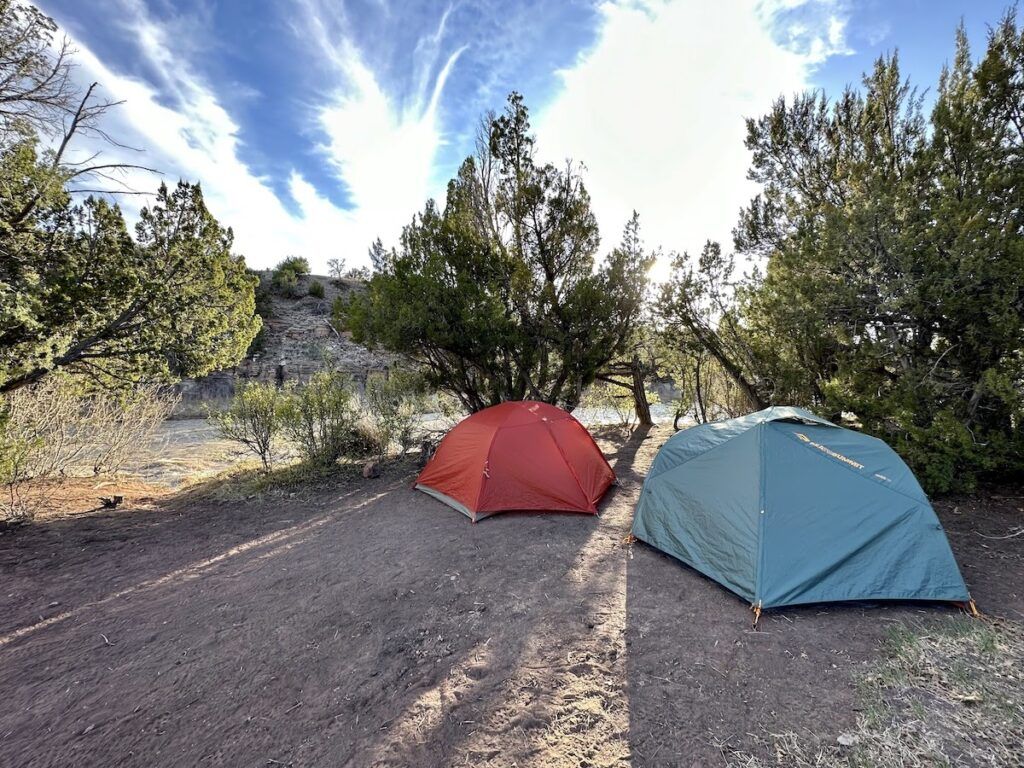
Anytime between the end of April and mid-October is a fantastic window for camping in New Mexico, particularly if you’re setting up in the northern regions. Camping during April and May especially is an adventure that can be come with with a few surprises that add excitement to the experience.
However, if you’re planning to venture into the state’s mountainous areas, be prepared for cooler — and sometimes harsher — conditions during the shoulder seasons.
I am a planner, and while I can make a schedule for the trip and think everything is organized for success, things do happen that are out of my control. Weather challenges, unanticipated road or park closures, seasonal considerations, and more can be instigators of a shift in plans. Keeping an open mind is a must!
With the right gear, a flexible attitude, and the spirit of exploration, you’ll find that the season’s unique challenges turn into rewarding memories.
Note: We do take breaks from camping during our road trip to take showers in more standard accommodations and give our kids some extra comfort.
Central New Mexico: Albuquerque
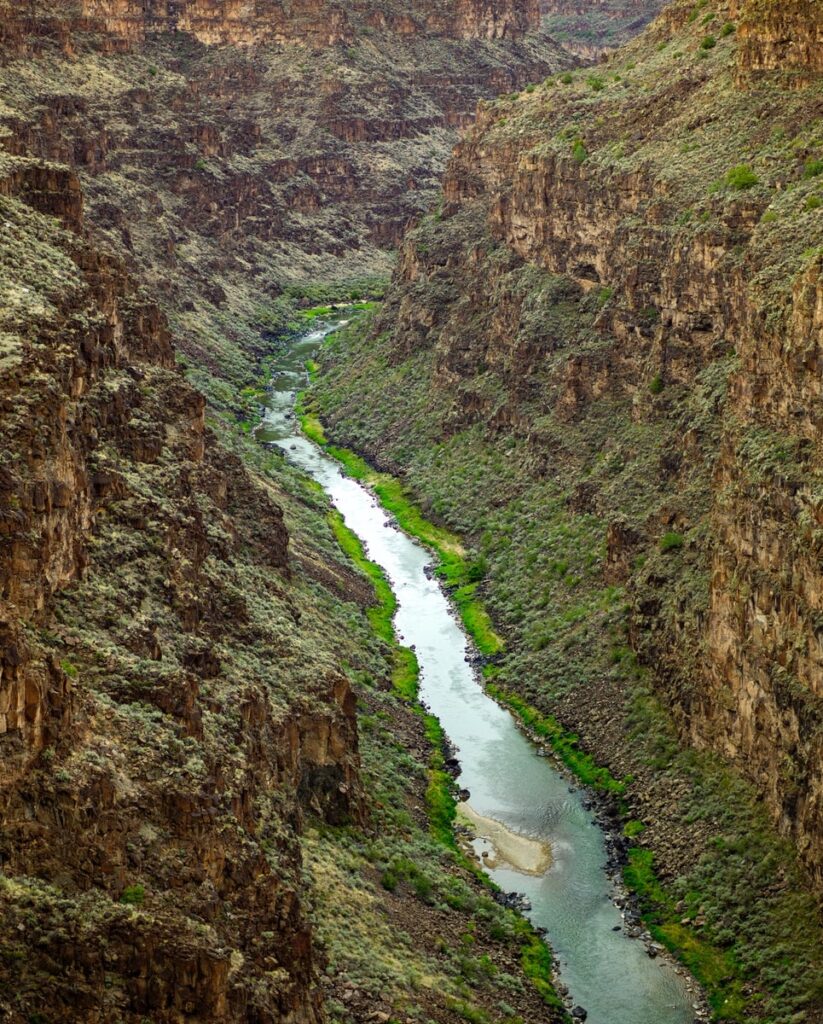
Our camping road trip started in Albuquerque. Then we drove to Santa Fe to stay with friends and get organized for our adventure. So, while we didn’t camp in the city’s immediate area, I will share my research and recommendations.
Albuquerque is not a sought-after camping destination, but KOA is worth checking out, and some of the surrounding areas are worthwhile.
Albuquerque KOA Journey: This campground located near I-40 has a variety of options, including tent sites, RV sites, and cabin rentals. With amenities like a swimming pool, free Wi-Fi, and a dog park, the KOA is a comfortable and convenient base for exploring the area around Albuquerque. The cost is $70-130 per night.
Turquoise Trail Campground (Cedar Crest): Nestled in the Sandia Mountains, Turquoise Trail offers scenic camping, with easy access to hiking trails and beautiful vistas. It’s a great spot for those looking to enjoy being in nature while still staying close to the city. The cost is $24-44 per night.
Manzanita Mountains Dispersed Camping: Located in the Cibola National Forest, this area provides excellent choices for dispersed camping, which is also free. The Manzanita Mountains are ideal for campers seeking a more rustic and remote experience, with the solitude and connection to nature that dispersed camping offers. Dispersed camping (camping in unmarked, undeveloped areas on public lands, often without amenities) is free.
North Central New Mexico: Santa Fe, Mora, Taos, Ghost Ranch
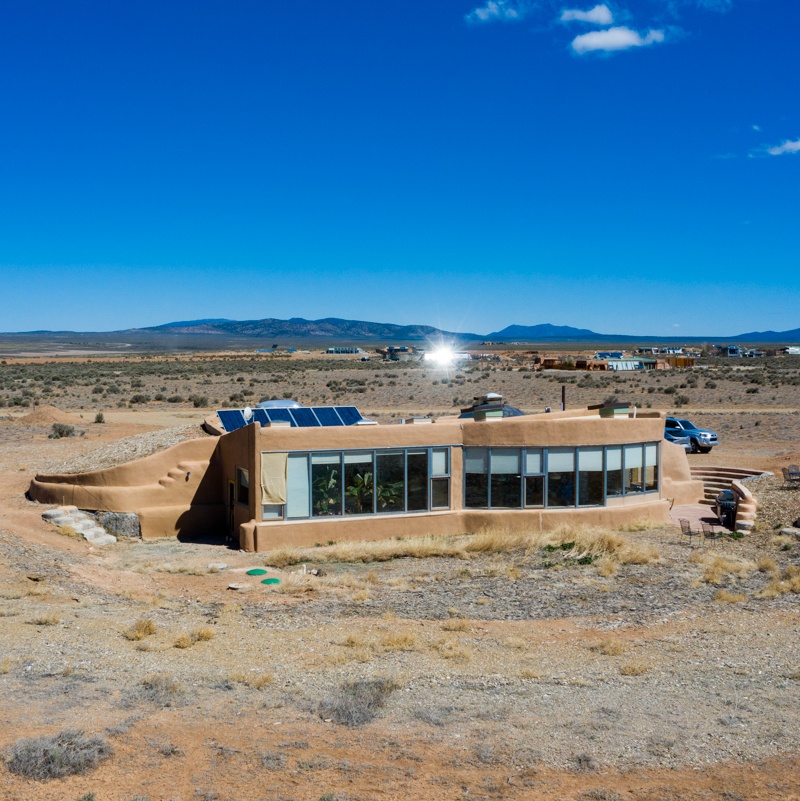
After loading up in Santa Fe on camping food supplies for our entire road trip, we headed toward Mora before traveling to Taos via Ocate.
This involved driving on the narrow, almost-one-lane NM-120. We had no signal on our cell phones and definitely thought we were lost, but the journey led us right to Taos!
We enjoyed a delicious meal at Guadalajara Grill for lunch, visited the Taos Pueblo, ate dinner at the Love Apple, and headed to our accommodation: the first earthship ever built.
In the morning, we headed to Ghost Ranch in Abiquiu for some hiking and an unforgettable trail ride, one of the highlights of our trip! If you ever have the opportunity to visit, I highly recommend the tours and trail rides.
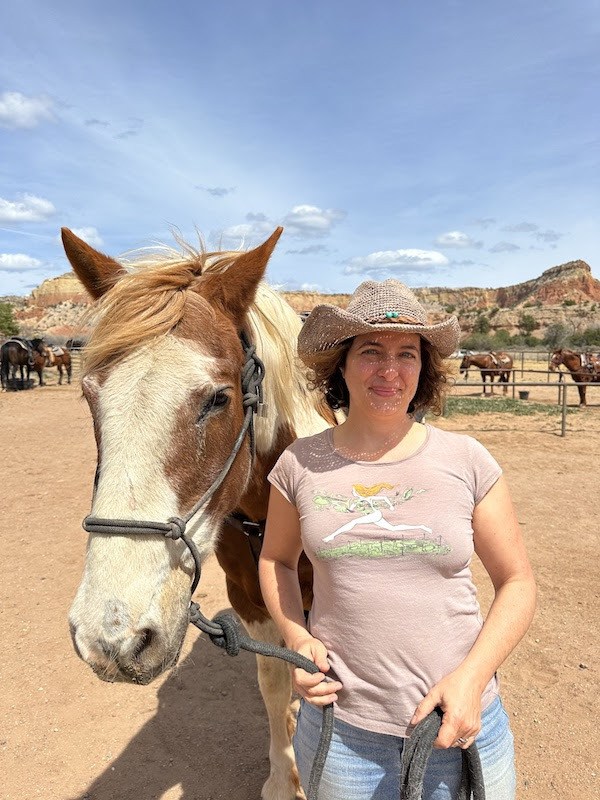

Trail rides should be booked well in advance on the Ghost Ranch website and cost $95-130 per person. A handful of tours can also be booked online, including the Georgia O’Keeffe Landscape Tour and Paleontology Tour. These range in price from $20 to $80 per person. (The price of the tours and trail rides includes the day pass fee.)
In addition, there is a seasonal campground at Ghost Ranch with tent sites, electricity, hookups, and a bathhouse that is open from May to October each year, though we were there too early in the spring to stay there.
Afterward, our family headed west. We planned to drive only five minutes down the road to camp at Echo Amphitheater for free. The problem was it was closed temporarily due to staffing shortages. We still enjoyed a gorgeous, easy walk up to the amphitheater, but we needed to camp elsewhere.
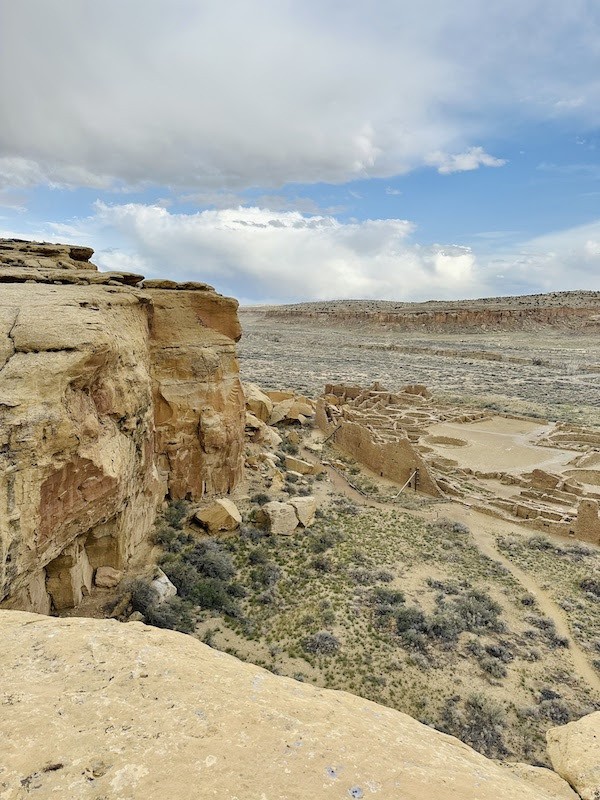
Undeterred, we drove down State Highway 151, trusting in our instincts to find dispersed camping. Spots appeared all along the Rio Chama, and we landed at a dispersed camping area right above the river, a designated spot called Whirlpool.
It was beautifully sunny, but April in New Mexico can be quite chilly, so we donned fleeces, hats, and base layers as nightfall approached. Morning brought gorgeous weather — and quarreling geese as they tried to claim the best nesting location. This was entertaining for all of us!
Santa Fe National Forest Campgrounds: Offering various scenic spots near the artistic city of Santa Fe, these campgrounds, like Black Canyon and Field Tract (currently closed, as of September 2023), immerse you in the beauty of the national forest, with lots of opportunities for hiking and exploration. The cost is $10/night.
Coyote Creek State Park: This campground is nestled in the Sangre de Cristo Mountains near Mora. The area is perfect for fishing, hiking, and relaxing in the tranquil surroundings. Campers can also enjoy amenities such as showers, electrical hookups, and hiking along a two-mile trail that crosses the creek. The cost is $14/night.
Tres Piedras Dispersed Camping: There is camping near the small community of Tres Piedras in the Carson National Forest, approximately 30 miles west of Taos, accessible via US Highway 64. There are unique rock formations and opportunities for outdoor activities, such as hiking and rock climbing. Dispersed camping is free.
Hotel Luna Mystica: This is a unique campground near Taos that offers a glamping experience with retro charm and modern comfort through its collection of restored vintage trailers, ranging in cost from $132 to $260/night. There are also communal fire pits for guests. The site’s stunning backdrop is the Taos Mesa.
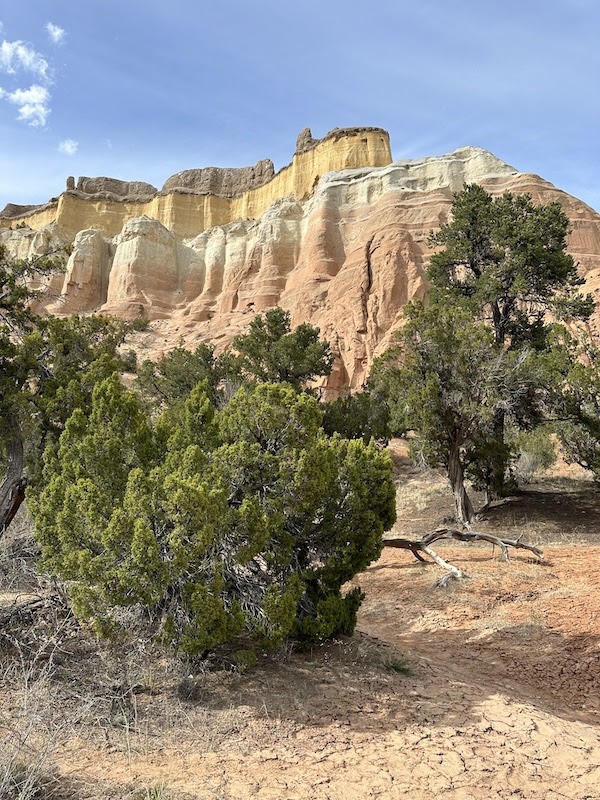
Echo Amphitheater: Located near Ghost Ranch, this is a stunning natural amphitheater known for its remarkable acoustics that create resonating echoes. The sandstone formation’s unique shape and vibrant red and orange hues make it a popular attraction. There are tent camping areas here that cost $2 per car.
Dispersed camping along State Highway 151: This is our adventurous find by the Rio Chama, where we discovered numerous remote locations for rugged camping right above the roaring river. The area is peaceful and quiet, and most of the spots we found were private. Dispersed camping is free.
Northwestern New Mexico: Chaco Canyon
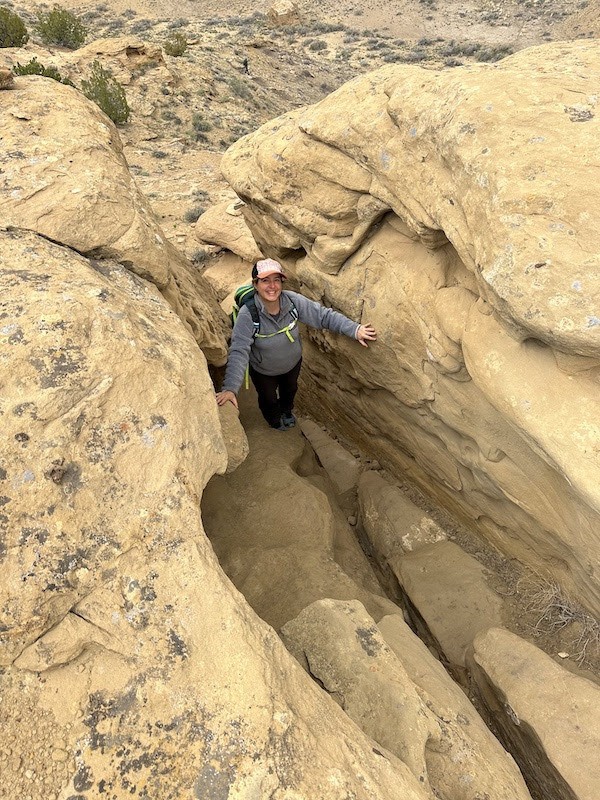
After leaving the Rio Chama dispersed camping area, we drove to Chaco Cultural National Historical Park, where we camped for the next two nights. We had originally planned to camp at Chaco Outlier the second evening, but a spot opened up for us at Gallo Campground, which gave us more time to hike.
Chaco Cultural National Historical Park, a UNESCO World Heritage Site, was the center of Puebloan culture from 850 to 1250 CE. It captivated me with its ancient architecture and inspiring natural landscapes unlike any other I have seen. It’s truly amazing to think that you’re walking the same paths as an ancient civilization that thrived here over a thousand years ago. It was another highlight of our New Mexico adventure.
The journey there was marked by a Wild West experience on the road, complete with a stallion, mare, and foal running loose, and a memorable attempt by their owner to lasso them.
Once at Chaco, we were greeted by wind-swept trails, which we enjoyed for two days. Both the hikes we completed, the South Mesa and Pueblo Alto Trails, were amazing and challenging, due to the high winds, meaning sand in our eyes and gusts that nearly blew us over.
The second afternoon, we came back from a hike and found that the intense desert winds blew fine sand into our tents through the mesh and zipped rain flies, requiring a thorough dusting off of our camping gear.
Despite the challenges, we laughed, enjoyed delicious meals, and embraced the adventure, making it a memorable part of our trip.
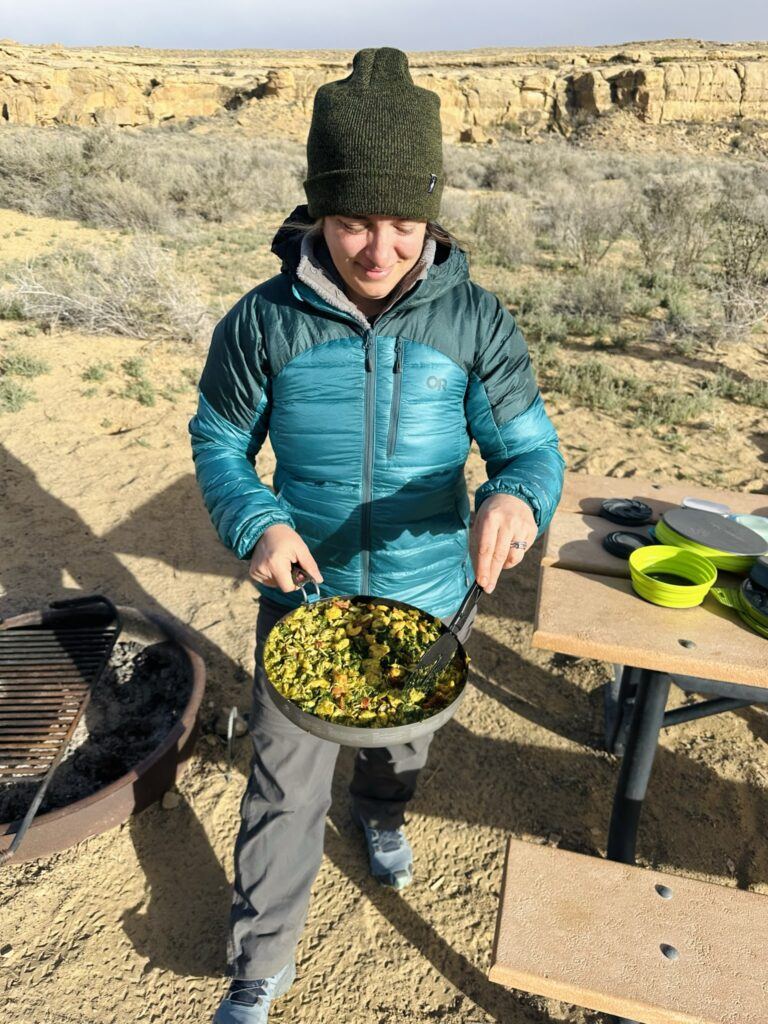
Gallo Campground: Located one mile east of the Chaco Canyon Visitor Center, Gallo Campground offers 32 individual sites and 2 group sites. However, it fills up fast, so make a reservation in advance ($20/night) or show up early in the morning to the Visitor Center to snag a last-minute cancelation. There are no showers or hookups, but the bathrooms are clean, and it’s a beautiful spot: a rugged, scenic environment surrounded by petroglyphs and a high-desert landscape.
Chaco Outlier: Located 19 miles south of Chaco Cultural National Historical Park, Chaco Outlier provides cabin and campground rentals. Guests have access to private hiking trails and can enjoy the seclusion of the area. It’s a great choice for those looking to explore the region’s natural beauty and historical significance. Contact Steve Williams for current pricing and availability: 505-655-3246 or 505-285-7120.
Navajo Lake State Park: Approximately two hours from Chaco Canyon, Navajo Lake State Park features a variety of camping options, including developed campgrounds with amenities and primitive beach camping. The park surrounds Navajo Lake, the second-largest in the state, providing opportunities for boating, fishing, and water recreation. Fees vary based on the type of site and amenities.
Angel Peak Scenic Area: About an hour’s drive from Chaco Canyon, Angel Peak Scenic Area offers nine developed campsites with picnic tables and fire grates. The area is known for its breathtaking badlands and the 7,000-foot Angel Peak, providing a scenic backdrop for camping. There are no fees for camping, and sites are available on a first-come, first-served basis.
Southern New Mexico: White Sands, Alamogordo, Carlsbad
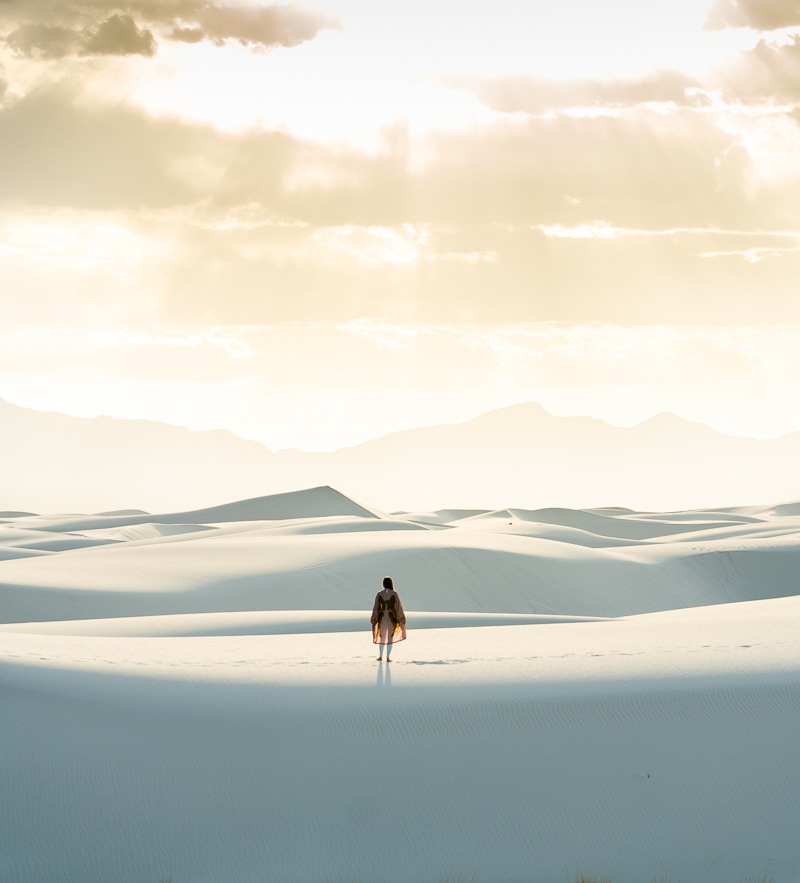
After the crazy winds at Chaco Canyon, our journey led us to Oliver Lee Memorial Campground, a refreshing, warm oasis that quickly became our favorite spot.
With clean hot showers and a sunset view, it was a welcome respite. We were rewarded with a hot, sunny day when we woke the next morning, perfect for hiking and exploring White Sands National Park.
The next leg of our trip began as we headed toward Cloudcroft, with plans for primitive camping later in the evening near Carlsbad Caverns.
However, as we approached, we discovered that the area was closed due to flooding damage. Such is life on a road trip in New Mexico! What does one do in such a situation, especially when hunger and fatigue set in?
We adapted by booking a last-minute hotel room in Artesia, where we enjoyed hot showers, a pool, and a relaxing indoor evening. It was a good detour that allowed us to recharge and prepare for the next and final adventure in the caves at Carlsbad Caverns.
Afterward, we dipped down for two nights into Guadalupe Mountains National Park and enjoyed hiking and camping at Pine Springs Campground, another great choice for camping because of its proximity to Carlsbad Caverns, before wrapping up our trip by flying out of Albuquerque.
Aguirre Spring Campground (Las Cruces): This campground, located at the base of the Organ Mountains, has 55 sites with picnic tables and grills. It’s a great base for hiking and enjoying the surrounding desert landscape. Fees are $7 per night for individual sites.
Gila Cliff Dwellings National Monument (Gila): For those interested in history and nature, camping near the Gila Cliff Dwellings offers a unique experience (and it’s free!). The nearby Gila National Forest provides dispersed camping options, and the Gila Hot Springs Campground ($10/per person per night) features a more developed experience with hot spring access.
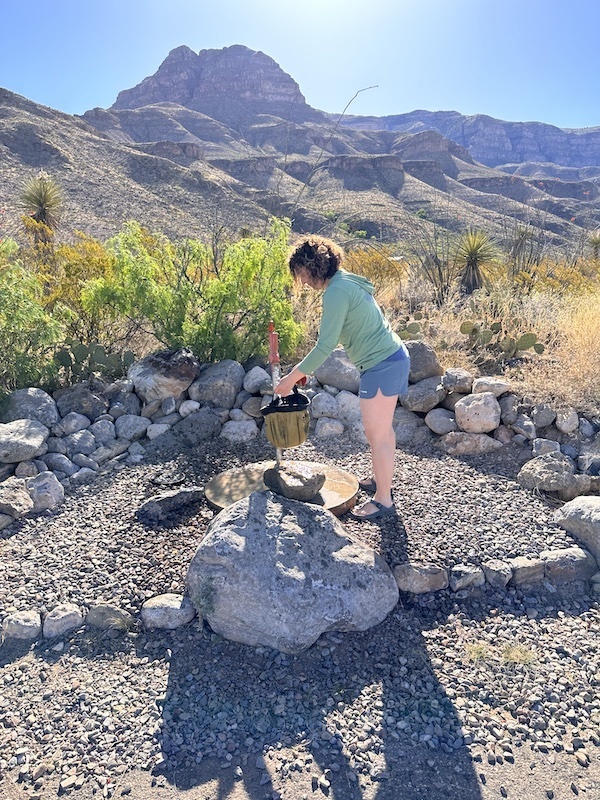
Oliver Lee Memorial Campground (Alamogordo): The campground is situated 12 miles south of Alamogordo. With clean, hot showers and a gorgeous view of the surrounding landscape, it’s a favorite spot for many campers, including our family. The area is ideal for hiking and exploring nearby attractions, such as White Sands National Park. The campground provides 44 developed sites, some with electric hookups, and fees range from $10 to $18 per night.
Sleepy Grass Campground (Cloudcroft): This campground in the Lincoln National Forest has 22 sites in a peaceful setting. It’s an excellent spot for hiking, picnicking, and enjoying the cool mountain air. Fees are $10 per night.
Carlsbad RV Park and Campground (Carlsbad): Just minutes from Carlsbad Caverns National Park, this campground offers full-hookup RV sites, tent camping, and cabin rentals. Amenities include a swimming pool, playground, and laundry facilities, making it a comfortable base for exploring the area. RV sites are $52.50 per night.
Backcountry Camping: Rattlesnake Canyon primitive camping, within Carlsbad Caverns National Park, is currently closed due to flooding in August 2022, but it will be a great option once it reopens (in the fall or winter of 2024), so keep checking for updates. Backcountry campers are required to obtain a free backcountry use permit at the Visitor Center.
Critical Things to Know about Camping in New Mexico
New Mexico is a big state with diverse ecosystems and a range of experiences to enjoy. Because of this, there are some critical things to know in order to ensure a safe and enjoyable camping trip:
1. Weather and temperature variations
- Spring/fall: These seasons can be quite pleasant but unpredictable. Evening temperatures can drop significantly, especially in higher elevations, like Santa Fe, Taos, and Chaco Canyon.
- Summer: Desert areas like White Sands can be extremely hot during the day and still warm at night. In contrast, mountainous regions like Taos may experience cooler evenings.
- Winter: Snow and freezing temperatures are common in northern areas and higher elevations. Even desert regions can get chilly at night.
2. Clothing requirements
New Mexico’s diverse geography means you’ll encounter a range of weather conditions, sometimes all in one day! Here’s a breakdown of what to pack, clothing-wise:
- Spring/fall in higher elevations: Despite the mild temperatures you might expect, it can get quite chilly, especially at night. Layering is key. Consider packing thermal base layers; a middle layer, like a fleece; and a windproof and waterproof outer layer. I also recommend a compact down coat. Don’t forget a warm hat and gloves!
- Summer in desert areas: Lightweight, breathable, and moisture-wicking fabrics are your friends. Long sleeves and pants can protect you from the sun, and a wide-brimmed hat is a must. Always carry a reusable water bottle to stay hydrated.
- Winter: If you’re brave enough to camp in the colder months, insulated, moisture-wicking clothing is essential. Think thermal layers, down jackets, and waterproof boots. Always pack extra socks!
- General: Regardless of the season, a good pair of hiking boots is essential for any camping trip. Make sure they’re broken in before you go, to avoid blisters. Also, pack some comfortable camp shoes or sandals for when you’re not on the trails.
3. Gear requirements
Always stay prepared by using stronger and warmer camping gear than you think you need. The elements can be rough at times in New Mexico, and good quality camping gear is super important.
- Tent: Use a tent that is rated high for withstanding windy conditions. Get one with a fine mesh fly and also a protective fly that you can zip down to keep debris out of your tent, such as fine sand.
- Sleeping bag: Always use a sleeping bag rated for temperatures that are colder than the forecasted conditions. For example, if you will be camping in 35-degree weather, bring a 20- to 25-degree sleeping bag, and use a liner to keep your bag clean and add a bit more warmth.
- Sun tarp: Consider bringing a tarp that can be easily set up in desert conditions, which will keep you out of the ongoing intense sunshine and heat while you cook, read, and relax at camp.
4. Altitude awareness
- New Mexico’s landscape ranges from low desert to high mountains. Be aware of altitude sickness symptoms, especially when camping in higher elevations like the Sangre de Cristo Mountains.
5. Fire restrictions and safety
- Fire regulations can vary by location and time of year. Always check local restrictions and follow proper fire safety guidelines.
6. Wildlife precautions
- From bears in the mountains to rattlesnakes in the desert, be aware of local wildlife and take appropriate precautions.
7. Water availability
- Water sources can be scarce, especially in desert areas. Always carry enough water and know where to find reliable sources. I typically make sure I have an extra gallon of water per day as a rule.
8. Leave-no-trace principles
- Practice responsible camping by following leave-no-trace principles, including packing out all trash and minimizing your impact on the environment.
9. Permits and regulations
- Some areas may require permits or have specific regulations for camping. Always check with local authorities or land management agencies.
10. Cultural sensitivity
- Respect Native American lands and cultural sites, especially in areas like Chaco Canyon, which has significant historical and cultural importance. Pay attention to signs and boundaries to be sure you are not trespassing.
11. RV vs. tent camping
- New Mexico has a mix of RV parks, developed campgrounds, and dispersed camping opportunities. Choose the right option for your needs and preferences.
- For tent camping, make sure your tent is sturdy and can withstand windy conditions. Know how to tie down your tent and stake it properly, so it doesn’t blow away!
12. Emergency preparedness
- Weather and conditions can change rapidly. Carry a well-stocked first-aid kit, know the nearest medical facilities, and have a plan for emergencies.
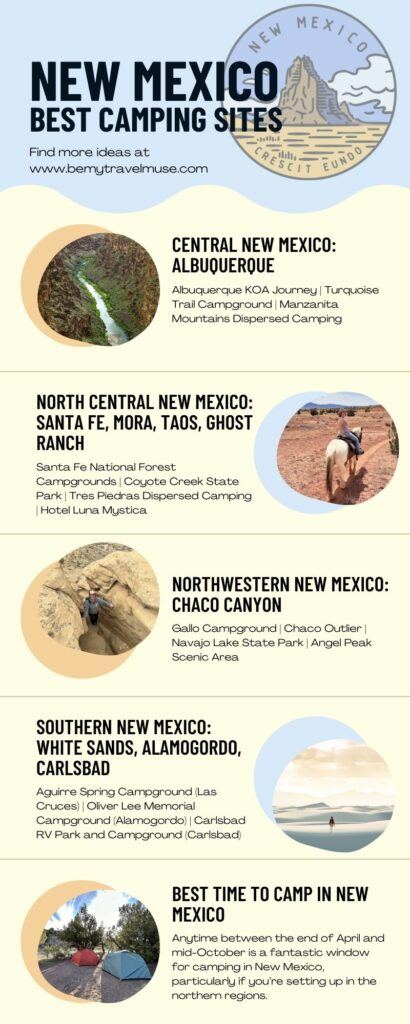
New Mexico’s diverse landscapes are calling your name, offering a tapestry of experiences that are bound to make your camping trip unforgettable!
With the right preparation and an adventurous spirit, you’re set for a journey through the Land of Enchantment that will leave you with memories to last a lifetime. Happy camping!
About the author: Heather Kasvinsky is a devoted foodie and outdoor adventurer, documenting her culinary and travel escapades on her blog, This Noshtalgic Life. Whether she’s camping in various locales or spending quality time backpacking near her off-grid cabin in Alaska, her love for exploration and good food shines through.
GG says
Thanks Heather for the comprehensive post on camping in beautiful New Mexico. I had colleagues who visited New Mexico for business and did not realize the elevation of Santa Fe is higher than Denver and needed a day or two to adjust so elevation awareness is essential! I hope to make it there one day. It sounds like a real outdoor adventurer and explorer’s playground with unique things to experience and don’t mind the need for flexibility, I would be just glad to make it there in the first place!
Heather Kasvinsky says
Hey GC, thanks for the note! Many people don’t realize how different Sante Fe is compared to the lower desert areas of the state. It can definitely take some getting used to – AND extra warm layers! 🙂 I hope you make it to New Mexico one day and try visiting some of the places I wrote about!